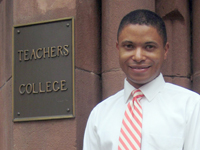When Tests Don't Tell the Full Tale
How do you accurately measure a child's proficiency in a particular subject? The results of even a well-designed test will be skewed toward those proficient in working within its specific format. Those who aren't may fare poorly, even when they're knowledgeable about the subject being tested. Thus "a test should be just one variable among many in determining a student's proficiency in a particular content area," says Douglas Wood, Executive Director of TC's National Academy for Excellent Teaching (NAfET).
How do you accurately measure a child's proficiency in a particular subject? The results of even a well-designed test will be skewed toward those proficient in working within its specific format. Those who aren't may fare poorly, even when they're knowledgeable about the subject being tested. Thus "a test should be just one variable among many in determining a student's proficiency in a particular content area," says Douglas Wood, Executive Director of TC's National Academy for Excellent Teaching (NAfET).
As one alternative to testing, NAfET, which provides literacy coaching and other professional development to high school teachers in underserved areas of New York City, is working with TC adjunct faculty member Evangeline Stefanakis to implement a system of digital portfolios at Fannie Lou Hamer Middle School in the Bronx. A digital portfolio is an electronic compendium of a student's work during the course of the school year. The portfolios formed by NAfET at Fanny Lou Hamer are tightly aligned with state curriculum standards.
Wood stresses that digital portfolios aren't intended to lessen students' responsibilities. "We're trying to marry the philosophy of an inquiry-based curriculum with state standards," he said, "This allows students, including special-needs and English Language-learning students, to demonstrate their proficiency in a rigorous, thoughtful way."
Indeed, Stefanakis recently argued in a New York Times opinion piece that the adoption of digital portfolios citywide would spare many immigrant children from being unnecessarily left back at the end of each school year. To that end, under the system she has helped create at Fannie Lou Hamer, teachers work with students at all levels to enter the students' work into the portfolios throughout the year. The portfolios include writing, math homework, science lab reports and multimedia work such as music and digital photography. "Students prefer documenting what they know with technology," Stefanakis says, "and this gives us a wider range of evidence of their capabilities."
Wood notes that the portfolio project also fights another common enemy of learning: boredom. He cited a recently released study from the Bill and Melinda Gates Foundation that found the most common reason students give for why they drop out of school is that "the classes weren't interesting."
"They don't see how their work in school is connected to anything in their lives," Wood says. But collaborating with teachers to build a portfolio gets students involved and leaves them with a product they can be proud of. "What's exciting for us is the level of interaction that is happening between teachers and students. Not only are the teachers excited, but the students are excited about the work. It even helps get parents involved in the process and that's always a good thing."
Stefanakis says that the experience with broad measurement and technology can help students in their lives outside school, as well. "The portfolios show us oral language, written language, audio/visual knowledge, teamwork and a students' ability to present his or herself through technology. These are all important skills for lifelong learning."
What's next for the project? Wood hopes to expand the program into other NAfET schools.
As for the students involved with the program so far, Stefanakis says they've shown remarkable growth. Portfolios "allow you to enter a reflecting phase," she says. "You can see what you've done and how you've grown, and they look at it and say -'I've got to do more.'"
Published Tuesday, Apr. 25, 2006
